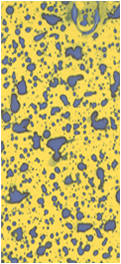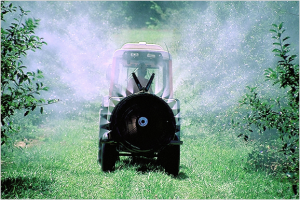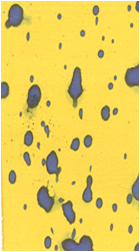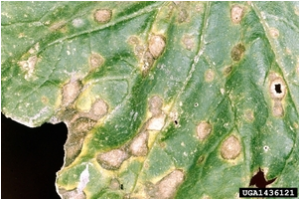Most fungicide failures are not due to resistance. Before assuming a pathogen surviving a fungicide application is resistant, eliminate other possible causes of poor control:
- Fungicide application
- Inadequate rate
- Poor spray coverage (illustrated below)
- Improper timing of application
- Antagonism between two or more products (wrong tank-mix partner)

Spray sensitive paper
showing good coverage
Read the label for rates and
compatibility with other products
Spray sensitive paper
showing poor coverage
- Environmental and plant growth conditions
- Excessively wet or dry soil
- Stress conditions, such as hot and dry
- Fungicide adsorption to soil particles or organic matter
- Wash-off of fungicide residues by rain or overhead irrigation
- New plant growth is not protected
- Fungi characteristics

Alternaria leaf spot on cantaloupe
- Incorrectly identified pathogen and wrong fungicide
used - Extremely high fungal populations
- Additional infections occur after the fungicide
treatment is no longer effective
- Incorrectly identified pathogen and wrong fungicide
Once other possible causes of poor control have been eliminated, the following are common features that characterize fields where fungicide resistance occurs:
- The field has a history of extensive use of the fungicide in question, especially at-risk fungicides (see Raised Resistance Risks), or fungicides with the same mechanism of action; and,
- Heavy reliance was placed on the fungicide with little to no non-chemical control methods used.
Early detection of fungicide resistance in the field is difficult. Resistance is first recognized when expectations of control are not met with application of the labeled dose of the fungicide. At that point in time, the genetic trait conferring resistance to the fungicide has become well established in the field population. A common method for diagnosing the level of resistance in a fungal population involves the determination of the resistance factor, or RF value, by comparing the fungicide’s lethal effects on a perceived resistant population with a susceptible laboratory colony. Increased RF values equate to potential resistance. Control is usually lost when the RF>10. Greater advances in resistance monitoring and detection are being investigated (click on “Monitoring Methods” at http://www.frac.info). For example, molecular DNA-based assays may provide a more rapid and reliable assessment of resistance, compared with conventional laboratory methods. The lack of a practical test to diagnose resistance raises the need to employ a proactive approach to avoid fungicide resistance in the first place.
Compiled by Dr. Wayne Buhler, PhD
